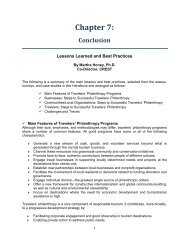Chapter 2: - Center for Responsible Travel
Chapter 2: - Center for Responsible Travel
Chapter 2: - Center for Responsible Travel
Create successful ePaper yourself
Turn your PDF publications into a flip-book with our unique Google optimized e-Paper software.
As time went on, we started to engage in sustainability debates, developmental debates. Westarted to recognize that simply giving money and goods was not sustainable. We lost boardmembers, we gained board members, and we kept increasing donations slowly.In all honesty, we made many mistakes, had great successes, debated, remained passionate,and slowly started to learn about travelers‘ philanthropy, <strong>Responsible</strong> Tourism, and bestpractice models. What we realized, with time, is that many of our challenges were common toother people trying to do the same thing. We were on the cutting edge, and not alone. This wasa relief!ProgressionWith time, from humble beginnings, we were able to employ staff. We started with anadministrator to write emails of thanks, to write updates, and to keep our small pool of donorsin<strong>for</strong>med. Then we added a field worker to monitor and engage with our projects. The funding<strong>for</strong> these jobs came from one of our clients,Saga Holidays, which has an extensiveCharitable Foundation.As we grew, we realized we had to limit ourscope, become more developmental andless charity driven, while monitoring andevaluating our impact. Today Calabash Trusthas 6 full time staff, and a clear focus onimproving schools in the townships of PortElizabeth and surrounding areas. Wesupport 8 schools, and have 6 Programareas: School Support and Advancement,Pre-School Support, Nutrition, SkillsDance per<strong>for</strong>mance on township tour, South Africa.Credit: Calabash ToursDevelopment, Micro-Enterprise Development, and Internal Learning and Growth. Each of theseprograms has a range of projects, but all of them work through schools to reach pupils,teachers, and parents.Some New ChallengesAs we grew our scope of work as Calabash Trust, we came to recognize that sustainable,innovative projects required higher capital input. <strong>Travel</strong>ers‘ philanthropy is not a predictable orsustainable source of revenue. (But which development aid is?) Funds come from many smalldonors, many of whom have no understanding of development. One of the Trust‘s keychallenges has been to stay needs-focused, rather than donor-driven. We still struggle with this,but are getting better about sticking to our operational plans, and not shifting our activities basedon the wishes of donors. Our need <strong>for</strong> capital to support our more ambitious projects led us tocourt donors within the NGO sector. Today, the Trust is funded by a mix of travelers‘philanthropy and traditional donors. But travelers‘ philanthropy – visitor contributions -- remainsvery much at the heart of our vision.Another challenge has been reconciling the commercial purposes of Calabash Tours and thedevelopmental mission of Calabash Trust. The two are symbiotic, intertwined, but separate, withseparate agendas. Making that relationship work has not always been easy. But through a40















